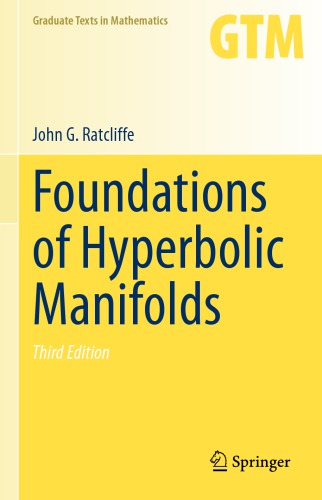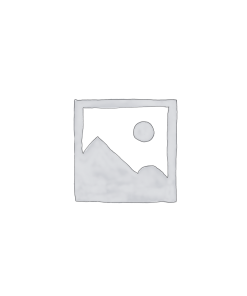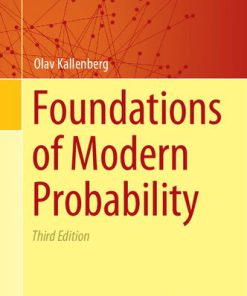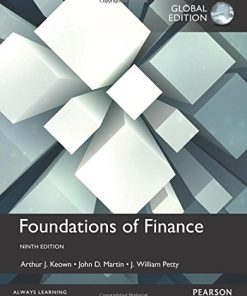Foundations of Hyperbolic Manifolds 3rd Edition by John Ratcliffe ISBN 9783030315979 3030315975
$50.00 Original price was: $50.00.$25.00Current price is: $25.00.
Foundations of Hyperbolic Manifolds 3rd Edition by John Ratcliffe – Ebook PDF Instant Download/Delivery: 9783030315979 ,3030315975
Full download Foundations of Hyperbolic Manifolds 3rd Edition after payment
Product details:
ISBN 10: 3030315975
ISBN 13: 9783030315979
Author: John Ratcliffe
Foundations of Hyperbolic Manifolds 3rd Edition Table of contents:
CHAPTER 1: Euclidean Geometry
§1.1 Euclid’s Parallel Postulate
Spherical-Hyperbolic Duality
Curvature
§1.2 Independence of the Parallel Postulate
The Conformal Disk Model
The Upper Half-Plane Model
The Hyperboloid Model
§1.3 Euclidean n-space
Metric Spaces
Isometries
Orthogonal Transformations
Group Actions
Characterization of Euclidean Isometries
Similarities
§1.4 Geodesics
Geodesic Lines
§1.5 Arc Length
Euclidean Arc Length
§1.6 Historical Notes
CHAPTER 2: Spherical Geometry
§2.1 Spherical n-space
Cross Products
The Spherical Metric
Spherical Geodesics
§2.2 Elliptic n-space
Gnomonic Projection
§2.3 Spherical Arc Length
§2.4 Spherical Volume
§2.5 Spherical Trigonometry
Area of Spherical Triangles
§2.6 Historical Notes
CHAPTER 3: Hyperbolic Geometry
§3.1 Lorentzian n-space
Lorentz Transformations
The Time-Like Angle between Time-Like Vectors
§3.2 Hyperbolic n-space
Lorentzian Cross Products
Hyperbolic Geodesics
Hyperplanes
The Space-Like Angle between Space-Like Vectors
The Time-Like Angle between Space-Like Vectors
The Angle between Space-Like and Time-Like Vectors
§3.3 Hyperbolic Arc Length
§3.4 Hyperbolic Volume
§3.5 Hyperbolic Trigonometry
Area of Hyperbolic Triangles
Triangles with One Ideal or Ultra-Ideal Vertex
Almost Rectangular Quadrilaterals and Pentagons
Right-Angled Hyperbolic Hexagons
§3.6 Historical Notes
CHAPTER 4: Inversive Geometry
§4.1 Reflections
Inversions
Conformal Transformations
§4.2 Stereographic Projection
Cross Ratio
§4.3 Möbius Transformations
The Isometric Sphere
Preservation of Spheres
§4.4 Poincaré Extension
Möbius Transformations of Upper Half-Space
Möbius Transformations of the Unit n-Ball
§4.5 The Conformal Ball Model
Hyperbolic Translation
§4.6 The Upper Half-Space Model
§4.7 Classification of Transformations
Elliptic Transformations
Parabolic Transformations
Hyperbolic Transformations
§4.8 Historical Notes
CHAPTER 5: Isometries of Hyperbolic Space
§5.1 Topological Groups
The General Linear Group
The Unitary Group
Quotient Topological Groups
§5.2 Groups of Isometries
Groups of Möbius Transformations
§5.3 Discrete Groups
Discontinuous Groups
§5.4 Discrete Euclidean Groups
Commutativity in Discrete Euclidean Groups
§5.5 Elementary Groups
Elementary Groups of Elliptic Type
Elementary Groups of Parabolic Type
Elementary Groups of Hyperbolic Type
Solvable Groups
§5.6 Historical Notes
CHAPTER 6: Geometry of Discrete Groups
§6.1 The Projective Disk Model
§6.2 Convex Sets
Sides of a Convex Set
§6.3 Convex Polyhedra
Faces of a Convex Polyhedron
Vertices of a Convex Polyhedron
§6.4 Geometry of Convex Polyhedra
Dihedral Angles
Links of a Convex Polyhedron
§6.5 Polytopes
Generalized Polytopes
Regular Polytopes
Schläi Symbols
Regular Ideal Polytopes
§6.6 Fundamental Domains
Fundamental Regions
Locally Finite Fundamental Regions
Rigid Metric Spaces
Untitled
Dirichlet Domains
§6.7 Convex Fundamental Polyhedra
Fundamental Polyhedra
§6.8 Tessellations
Side-Pairing
Cycles of Polyhedra
Cycle Relations
§6.9 Historical Notes
CHAPTER 7: Classical Discrete Groups
§7.1 Reflection Groups
Coxeter Groups
Coxeter Graphs
Enhanced Coxeter Graphs
§7.2 Simplex Reflection Groups
Spherical Triangle Reection Groups
Euclidean Triangle Reection Groups
Hyperbolic Triangle Reection Groups
Barycentric Subdivision
Tetrahedron Reection Groups
Bilinear Forms
Classification of Simplex Reection Groups
§7.3 Generalized Simplex Reflection Groups
§7.4 The Volume of a Simplex
The Schläfli Differential Formula
§7.5 Crystallographic Groups
Bieberbach’s Theorem
The Splitting Group
Bieberbach Groups
§7.6 Torsion-Free Linear Groups
Valuation Rings
Selberg’s Lemma
§7.7 Historical Notes
CHAPTER 8: Geometric Manifolds
§8.1 Geometric Spaces
Free Group Actions
X-Space-Forms
§8.2 Clifford-Klein Space-Forms
Spherical Space-Forms
Euclidean Space-Forms
Hyperbolic Space-Forms
§8.3 (X,G)-Manifolds
X-Space-Forms
Metric (X;G)-Manifolds
§8.4 Developing
(X;G)-Maps
The Developing Map
Holonomy
§8.5 Completeness
Geodesic Completeness
Complete (X;G)-Manifolds
§8.6 Curvature
§8.7 Historical Notes
CHAPTER 9: Geometric Surfaces
§9.1 Compact Surfaces
Orientability
Surfaces-with-Boundary
§9.2 Gluing Surfaces
The Generalized Gluing Theorem
§9.3 The Gauss-Bonnet Theorem
§9.4 Moduli Spaces
Moduli Space
Teichmüller Space
The Dehn-Nielsen Theorem
Deformation Space
§9.5 Closed Euclidean Surfaces
§9.6 Closed Geodesics
Closed Curves
§9.7 Closed Hyperbolic Surfaces
Pairs of Pants
Teichmüller Space
§9.8 Hyperbolic Surfaces of Finite Area
Complete Gluing of Hyperbolic Surfaces
Cusps
Discrete Groups
§9.9 Historical Notes
CHAPTER 10: Hyperbolic 3-Manifolds
§10.1 Gluing 3-Manifolds
§10.2 Complete Gluing of 3-Manifolds
§10.3 Finite Volume Hyperbolic 3-Manifolds
The Whitehead Link Complement
The Borromean Rings Complement
§10.4 Hyperbolic Volume
Orthotetrahedra
The Lobachevsky Function
The Volume of an Orthotetrahedron
Ideal Tetrahedra
§10.5 Hyperbolic Dehn Surgery
Parameterization of Ideal Tetrahedra
Gluing Consistency Conditions
Hyperbolic Structures on the Figure-Eight Knot
The Uniqueness of the Complete Structure
The Metric Structure of the Link
Metric Completion
The Dehn Surgery Invariant
Dehn Surgery
§10.6 Historical Notes
CHAPTER 11: Hyperbolic n-manifolds
§11.1 Gluing n-Manifolds
Complete Gluing of n-Manifolds
§11.2 Poincaré’s Theorem
Poincaré’s Fundamental Polyhedron Theorem
§11.3 The Gauss-Bonnet Theorem
§11.4 Simplices of Maximum Volume
§11.5 Differential Forms
Tangent Maps
Euclidean Differential Forms
The Bundle of Skew-Symmetric k-Linear Functionals
Hyperbolic Differential Forms
The Integral of an n-Form
The Volume Form
The Integral of a k-Form over a k-Chain
§11.6 Simplicial Volume
Straight Singular k-Simplices
Haar Measure
§11.7 Measure Homology
The Measure Chain Complex
The de Rham Chain Complex
Straightening
Smearing
Representing the Fundamental Class
§11.8 Mostow Rigidity
Lipschitz Conditions
Pseudo-isometries
Measure Homology
Rigidity
§11.9 Historical Notes
CHAPTER 12: Geometrically Finite n-manifolds
§12.1 Limit Sets
§12.2 Limit Sets of Discrete Groups
The Ordinary Set
Nearest Point Retraction
Classical Schottky Groups
§12.3 Limit Points
Conical Limit Points
Cusped Limit Points
Cusp Points
§12.4 Geometrically Finite Discrete Groups
Geometrically Finite Convex Polyhedra
Horocusps
The Convex Core
Geometrically Finite Groups
§12.5 Nilpotent Groups
§12.6 The Margulis Lemma
Margulis Regions
Parabolic Fixed Points
Finiteness Properties of Geometrically Finite Groups
§12.7 Geometrically Finite Manifolds
Geometrically Finite Hyperbolic Manifolds
The Ideal Boundary of a Hyperbolic Manifold
Cusps
Finiteness Properties of Geometrically Finite Manifolds
§12.8 Arithmetic Hyperbolic Groups
Algebraic Integers
Number Fields
The Orthogonal Group of a Quadratic Form
Admissible Quadratic Forms
Arithmetic Hyperbolic Groups of the Simplest Type
Haar Measure
Compactness Criteria
§12.9 Historical Notes
CHAPTER 13: Geometric Orbifolds
§13.1 Orbit Spaces
§13.2 (X,G)-Orbifold
Order of a Point
Two-Dimensional Compact Geometric Orbifolds
Metric (X;G)-Orbifolds
§13.3 Developing Orbifolds
(X;G)-Paths
Homotopic (X;G)-Paths
Fundamental Orbifold Group
Holonomy
Universal Orbifold Covering Space
The Developing Map
Complete (X;G)-Orbifolds
§13.4 Gluing Orbifolds
Complete Gluing of Orbifolds
§13.5 Poincaré’s Theorem
Poincaré’s Fundamental Polyhedron Theorem
§13.6 Historical Notes
Bibliography
Index
People also search for Foundations of Hyperbolic Manifolds 3rd Edition:
john g ratcliffe foundations of hyperbolic manifolds
foundations of hyperbolic manifolds springer
hyperbolic manifolds
foundations of differentiable manifolds and lie groups pdf
Tags:
John Ratcliffe,Foundations,Hyperbolic Manifolds
You may also like…
Mathematics - Geometry and Topology
Lectures on the Geometry of Manifolds 3rd Edition by Liviu Nicolaescu 9789811215957 9811215952
Science (General)
Foundations of Elastoplasticity Subloading Surface Model 3rd Edition Koichi Hashiguchi (Auth.)
Religion & Spirituality - Christianity
Physics - Quantum Physics
Foundations of Quantum Field Theory 3rd Edition Klaus Dieter Rothe
Engineering - Telecommunications
Foundations of Radio for Scientists and Technologists Christopher John Coleman
Business & Economics - Personal Finance
Business & Economics
Foundations of Modern Macroeconomics 3rd Edition Ben J. Heijdra












